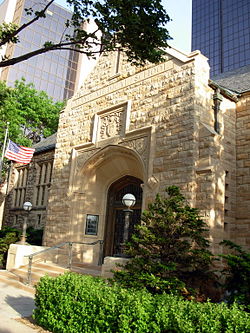| Revision as of 06:27, 15 February 2012 edit174.125.229.134 (talk) →Location← Previous edit | Revision as of 20:02, 27 April 2012 edit undoJakebarrington (talk | contribs)1,004 editsNo edit summaryNext edit → | ||
| Line 1: | Line 1: | ||
| ] | ] | ||
| ] | ] | ||
| '''Mayo Medical School''' is a part of the ] in ], United States. It grants ], and is accredited by the ]. | '''Mayo Medical School''' is a part of the ] in ], United States. It grants ], and is accredited by the ]. Currently, it is considered the most selective school in terms of acceptance rates. It had an acceptance rate of 2.2% in the year 2010. <ref>http://www.usnews.com/education/best-graduate-schools/articles/2011/04/05/10-medical-schools-with-lowest-acceptance-rates</ref> | ||
| ==History== | ==History== | ||
Revision as of 20:02, 27 April 2012


Mayo Medical School is a part of the Mayo Clinic in Rochester, Minnesota, United States. It grants degrees in medicine, and is accredited by the North Central Association of Colleges and Schools. Currently, it is considered the most selective school in terms of acceptance rates. It had an acceptance rate of 2.2% in the year 2010.
History
The Mayo Clinic has a long history of medical education, and was a pioneer in post-graduate education for doctors. In 1972, Mayo Medical School opened its doors to 40 students for the first Mayo Medical School class chosen from 473 applicants. In its short history the school has risen to become one of the leading medical schools in the United States. Today, the class size is still very small and select by American medical school standards. In addition to allowing for high selection standards and significant individual student attention, the class size is small in part because every medical student at the school receives financial assistance from the Mayo Foundation, with all students receiving at least half tuition scholarships. A large amount of need-based aid is also available. This is in line with the Mayo philosophy that the medical school should be able to train the best and brightest from all over the world, regardless of the ability of a student to pay for their medical education.

Location
Mayo Medical School is located in the heart of downtown Rochester, and has over 26,000 Mayo faculty, staff, and students. The MMS campus activity is centered around the Mitchell Student Center next to the Mayo and Gonda buildings. These interconnected buildings, together with Rochester Methodist Hospital, comprise the core of Mayo's clinical practice facilities in downtown Rochester.
Student life
Mayo students attend classes and conduct laboratory exercises in the adjacent Guggenheim Building for Research and Education, the new Stabile Building, and the Siebens Medical Education Building. Within the Stabile Building is the new, state-of-the-art anatomy laboratory. While most education takes place in these buildings, students enjoy educational opportunities in almost every Mayo facility, as well as being able to partake in funded rotations at the Mayo facilities in Arizona and Florida. Mayo Medical Students can also take advantage of funded international rotations and medical volunteer trips, paid for by the Clinic and taken between normal instructional rotations.
Curriculum
Mayo Medical School students start their school year in mid-July, with first year students taking a hybrid orientation and public health course. The curriculum is divided into three and six week blocks, with students take one class at a time. A list of the blocks and their titles is show below:
Year 1
Block 1 - Orientation and Improving the Public's Health
Block 2 - Basic Structure (Histology and Genetics)
Block 3 - Human Structure (Anatomy and Radiology)
Block 4 - Improving the Public's Health
Block 5 - Normal Function (Pathology and Immunology)
Block 6 - Principles of Disease, Diagnosis, and Treatment (Microbiology and Immunology)
Block 7 - Brain and Nervous System
Year 2
Block 8 - Fluids
Block 9 - Circulation
Block 10 - Nutrition & Digestion
Block 11 - Respiration
Block 12 - Musculoskeletal & Hormones
Block 13 - Blood & Immunity
Classes during the first two years are offered on a Pass/Fail basis, with no internal ranking of students. This produces a cooperative environment that fosters learning and collaboration. During the first two years, medical school students have the opportunity to take part in self-designed selectives, which are generally two week periods that separate each block. Selectives allow students to shadow physicians, travel abroad on volunteer trips, or present research. If a student chooses, they may participate in selectives offered through Mayo Medical School, though self-proposed selectives are allowed.
Saint Marys Hospital and Rochester Methodist Hospital are integral to the Mayo campus, providing essential inpatient learning experiences for medical students. The Mayo Clinic College of Medicine also includes programs in physical therapy, dentistry, physician assistant, and postgraduate residency and fellowship training programs. The Physician Assistant program is also affiliated with the University of Wisconsin–La Crosse, and students at the Medical School have the option to pursue several combined degree programs with other universities (MD-PhD, MD-MBA, and MD-MPH).
Notes
- http://www.usnews.com/education/best-graduate-schools/articles/2011/04/05/10-medical-schools-with-lowest-acceptance-rates
- Tuition
- PA program
External links
Categories: